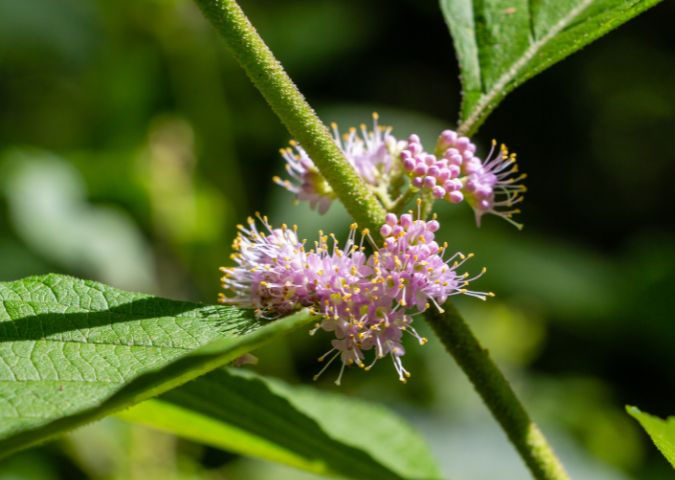New This Week
September 23, 2024

Big Beautyberry Sale!
Learn about this native shrub that supports so much wildlife!
In honoring keystone species this week, we’re offering a buy-two-get-one-free sale on a native shrub that supports so much wildlife! Don’t have room for all three in your garden? I bet you have a neighbor or friend who would love to add one to their landscape!
American Beautyberry
Callicarpa americana

American beautyberry is a fast growing, native, deciduous shrub mostly known for the magnificent violet-magenta berry display in late September and early October. The bright berries are a color not often seen in nature and their arrangement of tight clusters around the leaf nodes are just as unusual. While not one for stunning fall color, the anemic looking green leaves will quickly turn yellow before abscission, but the loss of leaves unveil the colorful, bright berries. The shrub is high-impact visually, a trait that benefits both the viewer and wildlife when planted en masse.

Since the blooms and berries are borne on new growth, pruning is best done in late winter before leafing out. Prune down to 6-18” from ground if you’d like to keep the shrub looking its best. If left unchecked, the shrub can reach up to 8 feet tall and wide. American beautyberry does tend to get a little scraggly as it ages and benefits from a cleanup each year with removal of dead limbs at the very least.
American beautyberry is considered a pioneer species, often appearing in open areas after land is cleared. This makes it an exceptional beneficial species as it provides a source of nutrient dense food for birds, mammals, and other wildlife in a landscape that could be going through transition and may not have a bounty of food or shelter at that moment in time. Nectar and pollen in early summer blooms attract native bees and butterflies. Pioneer species are generally tough plants that can handle volatile conditions.
Beautyberry is highly tolerant of fire, drought (once established), and heavy browsing by animals. But with the hardy traits comes an intolerance of shade, so it often declines when mid-story vegetation is dense. When planting in the landscape make sure to keep the shrub at the edge of the woods or in open areas.

American beautyberry is a host plant for the rustic sphinx moth, spring azure butterflies, and snowberry clearwing moths. The fruit are high in moisture content, protein, and fat and provide food to over forty species of songbirds including American robin, cedar waxwings, warblers, finches, and the eastern towhee as well as mammals including armadillo, foxes, opossum, racoon, and squirrels. The fat content in the berries means amazing fuel for migrating birds in fall and winter when the fruit are present. American beautyberry has 70% fat content in the berries--as a comparison spicebush has 50% and native dogwoods have 25%. Asian beautyberries only have somewhere around 5% fat content.
Asian beautyberries were introduced to the US in 1845 and are often found in commercial and home landscapes. Not only are they considered invasive, but they can also hybridize with our native beautyberry. The hybridization can weaken the berries' nutritional value, favorable nesting habitat, palatability to host caterpillars, decrease berry size and the overall genetic strength of our native American beautyberry. You can identify Asian beautyberries by their looser fruit clusters that dangle further from the stem and ripen much earlier than the American species (August/early September). The branches on the Asian species are longer and weeping in habit and do not support nesting as much as the native species.
One American beautyberry shrub can bear 3-5 pounds of fruit in one season and it’s not just enjoyed by wildlife, but humans as well! The fruit is not juicy, but more of a pithy pulp with a mild sweet taste with spicy notes, similar to Asian five spice. Harvest when the fruit tastes best after nighttime temps have dipped in the low 40s, but before fruit has experienced multiple freezes. You can find several recipes online for extracting the juice and making jelly.

NAME:
Callos means “beauty” and carpos means “fruit”.
NATIVE RANGE:
Distributed through the southeastern United States from Texas east to Maryland. It grows in the Caribbean and northern Mexico, too.
FUN FACT:
American beautyberry has antibacterial and pest-deterring properties. Native American tribes used roots, leaves and branches to treat malarial fevers, rheumatism, stomachaches and dysentery. In the early 20th century, farmers would crush the leaves and place them under the harnesses of horses and mules to repel mosquitoes. Crushing leaves and rubbing on your skin can also deter fire ants, ticks, deer flies and mosquitoes. Some people are allergic to the hairy leaves and it may cause contact dermatitis--make sure you’re not allergic before applying directly to your skin. The two compounds responsible for the repellant are callicarpenal and intermedeol.
GROWING CONDITIONS:
SOIL: Prefers well-drained, moist soil rich in organic matter, but can tolerate sand or clay soils, too. Appreciates mulch to help keep roots protected and moist while becoming established. Handles a wide range of pH levels (4.8-7.0).
SUNLIGHT: Full sun is best for fruit production, but can tolerate light shade
HEIGHT/WIDTH: 3-8’ tall and wide--size can be easily managed with pruning in late winter/early spring
ZONES: (6)7-10 – American beautyberry is intolerant to cold temperatures in single digits or below, especially in younger more susceptible plants. If growing in zone 6, planting in a container and moving under cover in the winter could be beneficial.
.png)